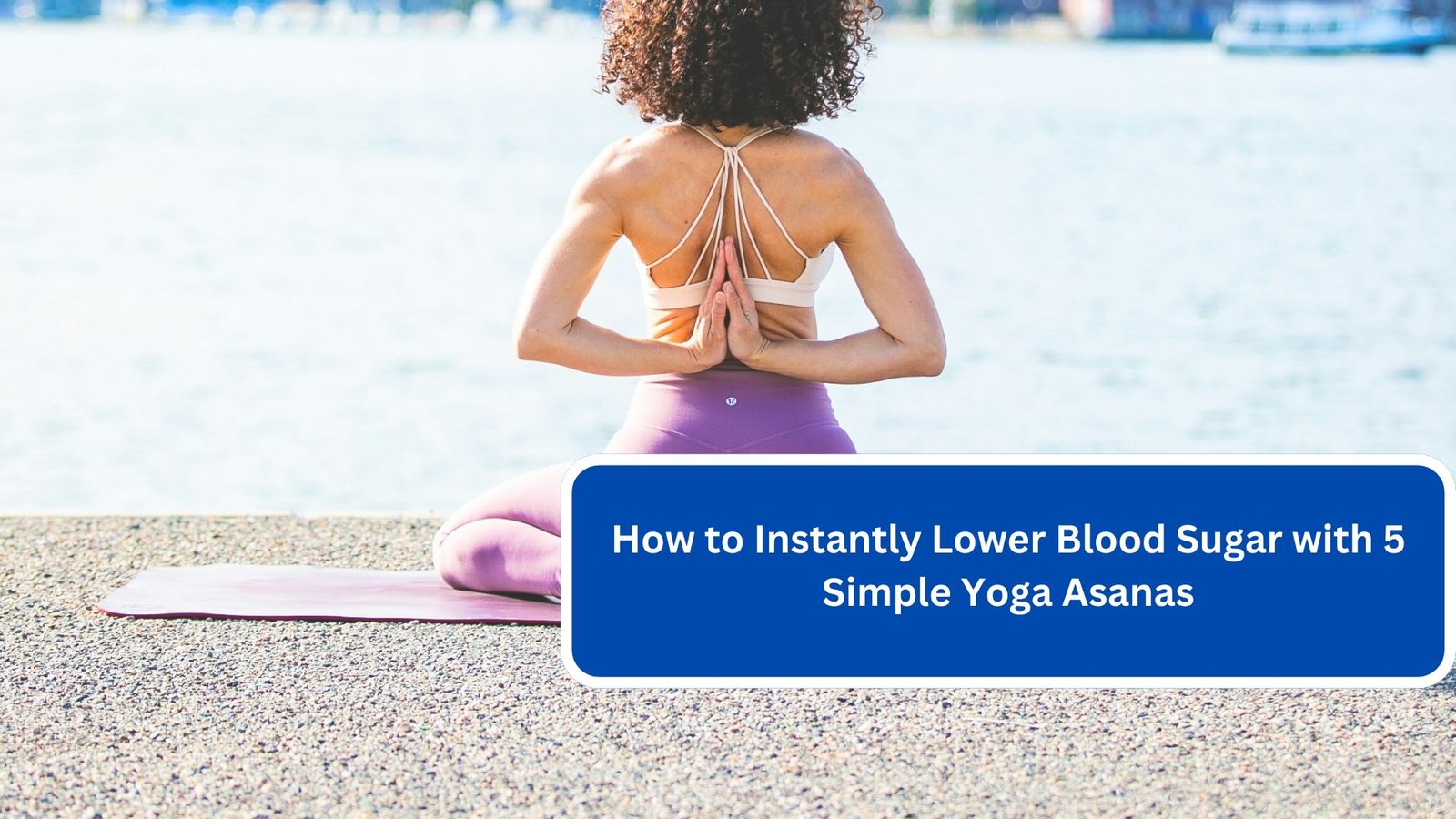Managing blood sugar levels is crucial for individuals with diabetes and prediabetes, as well as for anyone looking to maintain optimal health. High blood sugar, or hyperglycemia, can lead to a range of serious health issues if left unchecked. While diet and medication are critical for blood sugar management, incorporating regular physical activity, particularly yoga, can also play a vital role. In this article, we will explore how yoga can help lower blood sugar levels and provide detailed instructions for five simple yoga asanas (postures) that can be practiced at home.
Understanding Blood Sugar and Its Implications
Blood sugar levels indicate how much glucose is circulating in the bloodstream at any given time. After meals, blood sugar levels typically rise, which triggers the pancreas to release insulin—a hormone that helps cells absorb glucose for energy. However, when blood sugar levels remain elevated for extended periods, it can lead to:
- Diabetes: A chronic condition characterized by high blood sugar levels due to insulin resistance or insufficient insulin production.
- Heart Disease: High blood sugar is a significant risk factor for cardiovascular problems.
- Kidney Damage: Prolonged high blood sugar can affect kidney function and lead to chronic kidney disease.
- Nerve Damage: Neuropathy can occur as a result of elevated blood sugar levels, leading to numbness and pain.
Maintaining balanced blood sugar levels is essential for overall health and well-being. Regular exercise, including yoga, can help improve insulin sensitivity and support metabolic health.
The Role of Yoga in Blood Sugar Management
Yoga is a mind-body practice that combines physical postures, breathing exercises, and meditation. The benefits of yoga for blood sugar management include:
- Improved Insulin Sensitivity: Regular yoga practice can enhance insulin sensitivity, making it easier for the body to use glucose effectively.
- Stress Reduction: Yoga helps reduce stress, which can contribute to high blood sugar levels. Stress triggers the release of cortisol, a hormone that can elevate blood sugar.
- Increased Physical Activity: Practicing yoga promotes movement and flexibility, contributing to overall physical fitness.
- Mindfulness and Body Awareness: Yoga encourages mindfulness, helping practitioners make healthier lifestyle choices that can impact blood sugar levels.
Key Asanas for Lowering Blood Sugar
Below are five simple yoga asanas that can help lower blood sugar levels quickly and effectively. These postures are suitable for all fitness levels and can be practiced at home without special equipment.
1. Vajrasana (Thunderbolt Pose)
Benefits: Vajrasana is known for aiding digestion and regulating blood sugar levels. It calms the mind and reduces stress, promoting better overall health.
Instructions:
- Start by kneeling on the floor with your thighs perpendicular to the ground.
- Sit back on your heels, ensuring your feet are flat on the ground.
- Keep your spine straight, shoulders relaxed, and hands resting on your thighs.
- Close your eyes and take deep, steady breaths, focusing on your inhalations and exhalations.
- Hold the position for 5-10 minutes, maintaining a calm and relaxed state.
Tip: This asana can be practiced after meals to aid digestion and help stabilize blood sugar levels.
2. Bhujangasana (Cobra Pose)
Benefits: Bhujangasana strengthens the spine, improves flexibility, and stimulates the abdominal organs, promoting better blood circulation and digestion.
Instructions:
- Lie flat on your stomach with your legs extended and feet together.
- Place your hands under your shoulders, keeping your elbows close to your body.
- Inhale deeply and slowly lift your chest off the ground while keeping your pelvis pressed down.
- Arch your back gently, looking upward without straining your neck.
- Hold the position for 15-30 seconds while breathing deeply.
- Exhale and lower your chest back to the floor.
Tip: Practice this pose in the morning to energize your body and stimulate digestion.
3. Adho Mukha Svanasana (Downward-Facing Dog Pose)
Benefits: This pose stretches the entire body, improves blood flow, and calms the nervous system. It can help reduce stress and anxiety, which are often linked to elevated blood sugar levels.
Instructions:
- Begin in a tabletop position with your hands under your shoulders and knees under your hips.
- Exhale and lift your hips up and back, straightening your legs and arms.
- Your body should form an inverted “V” shape, with your head between your arms.
- Keep your heels reaching toward the ground and your spine straight.
- Hold the position for 30 seconds to 1 minute while breathing deeply.
Tip: This pose can be included in your routine whenever you feel stressed or overwhelmed.
4. Setu Bandhasana (Bridge Pose)
Benefits: Setu Bandhasana opens the chest, strengthens the back, and stimulates the abdominal organs, promoting better blood circulation and digestion.
Instructions:
- Lie on your back with your knees bent and feet flat on the floor, hip-width apart.
- Place your arms at your sides, palms facing down.
- Inhale deeply and lift your hips toward the ceiling, pressing through your feet and shoulders.
- Clasp your hands under your back or keep your arms flat on the ground.
- Hold the position for 30 seconds to 1 minute while breathing steadily.
- Exhale and lower your hips back to the floor.
Tip: This pose can be helpful for relieving stress and anxiety, contributing to better blood sugar control.
5. Paschimottanasana (Seated Forward Bend)
Benefits: This asana stretches the spine and hamstrings, calms the mind, and stimulates the digestive system, helping to regulate blood sugar levels.
Instructions:
- Sit on the floor with your legs extended straight in front of you.
- Inhale and raise your arms overhead, lengthening your spine.
- Exhale and hinge at your hips, reaching forward to grasp your feet or shins.
- Keep your back straight and avoid rounding your spine.
- Hold the position for 30 seconds to 1 minute while breathing deeply.
Tip: This pose can be particularly effective in the evening, promoting relaxation and mindfulness before bedtime.
Integrating Yoga into Your Routine
To effectively lower blood sugar levels, consider the following tips for integrating yoga into your daily routine:
- Consistency is Key: Aim to practice these asanas regularly, ideally daily or at least several times a week.
- Create a Relaxing Space: Designate a quiet, comfortable area in your home for your yoga practice, free from distractions.
- Listen to Your Body: Pay attention to how your body feels during each pose. Modify or skip any movements that cause discomfort.
- Combine with Breathing Techniques: Pair your asanas with deep breathing exercises to enhance relaxation and mindfulness.
- Stay Hydrated: Drink water before and after your yoga session to keep your body hydrated and support metabolic processes.
Additional Lifestyle Changes for Blood Sugar Management
While yoga can significantly impact blood sugar control, consider incorporating other lifestyle changes to optimize your results:
- Balanced Diet: Focus on a diet rich in whole foods, including fruits, vegetables, lean proteins, and whole grains. Limit refined sugars and processed foods.
- Regular Exercise: In addition to yoga, engage in other forms of physical activity, such as walking, cycling, or swimming.
- Stress Management: Incorporate stress-reducing practices such as meditation, deep breathing, or spending time in nature.
- Monitor Blood Sugar Levels: Regularly check your blood sugar levels to track your progress and identify patterns related to diet and activity.
Conclusion
Incorporating yoga into your daily routine can be an effective and natural way to lower blood sugar levels and promote overall well-being. The five asanas highlighted in this article—Vajrasana, Bhujangasana, Adho Mukha Svanasana, Setu Bandhasana, and Paschimottanasana—are simple yet powerful tools for managing blood sugar. By combining these practices with a balanced diet, regular physical activity, and stress management techniques, you can take significant steps toward maintaining healthy blood sugar levels and improving your quality of life.
Remember, it’s essential to consult with a healthcare professional before making any significant changes to your exercise or dietary regimen, especially if you have underlying health conditions. With consistency and mindfulness, yoga can serve as a valuable ally in your journey toward better health.

